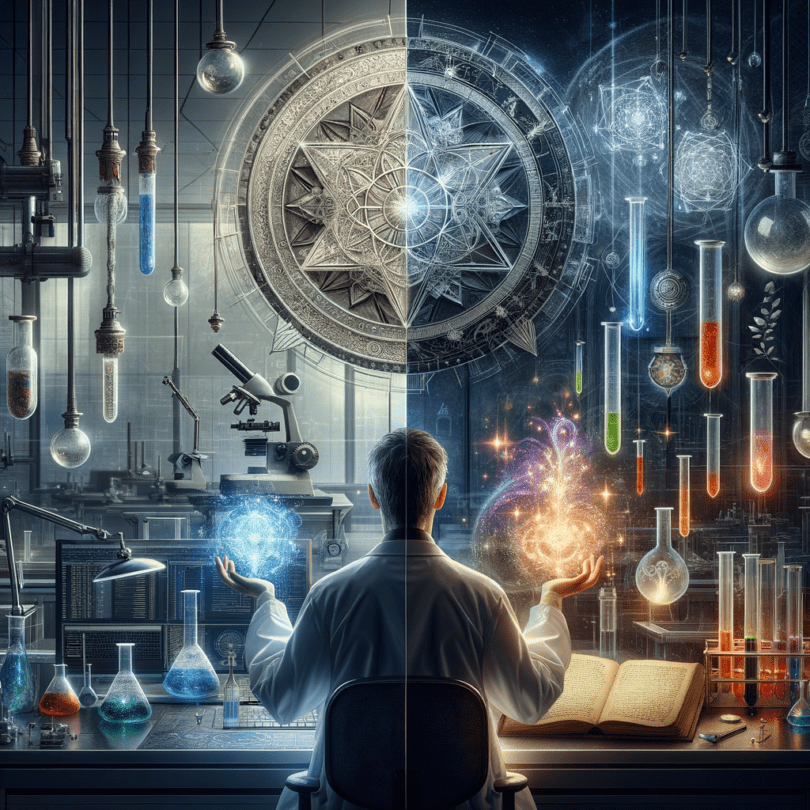Have you ever caught yourself staring at a magician, utterly mesmerized, and thought, “I wish I could figure out how they did that”? Or maybe you’re like me: endlessly curious about the world, constantly imagining what would happen if the orderly world of science were to tango with the whimsical wonderland of magic. It’s a funny thought, isn’t it? Could they boost each other to new heights, or would they just explode in a shower of colorful fireworks? Honestly, thinking about it gives me a bit of a thrill. Let me take you on a little mental adventure, where we’ll mix up stories, theories, and a big dollop of imagination.
To me, magic is more than just a bit of hocus-pocus. It’s this delightful escape, where the impossible becomes, just for a moment, something tangible. On the flip side, science is all about peeling away the universe’s layers. It’s like a magnifying glass for discovering what makes the world tick in a logical kind of way. It’s astonishing how two such different worlds are so intrinsically tied together.
The Science Behind Magic?
Take a seat in a magician’s audience, and watch them saw somebody in half or pull a plump rabbit from a seemingly empty hat. It feels like reality has just taken a back seat. But here’s a secret — and I love this part — sometimes, if you poke around, you’ll find these tricks are just nifty combinations of science and skill. Levitating magician? Not too different from how planes soar through the skies by manipulating the same old physics. It’s comforting to realize our world of logic isn’t so far removed from the glitter of magic.
There’s another fun bit: magic is actually a sandbox where science plays dress-up. Think about those mind-bending optical illusions. They don’t just entertain; they teach us how our brains perceive this funky world of ours. Magicians, the best of them, are like psychologists with a dash of flair. Isn’t it wild that while one field carves out the basics of understanding, the other joyfully twirls around those rules, tricking us with glee? It’s not a showdown but a joyful jig between science and the allure of sorcery.
A Clash or Collaboration?
Imagine science and magic as dinner guests. Science would probably sit there with their elbows on the table, asking endless questions, while Magic waltzes around, breaking the rules and giggling. Would there be tense fork-and-knife standoffs, or could they team up for an amazing, world-changing collaboration?
I see beauty in their potential partnership. Somewhere in the whispers of history lie scientists dabbling in mystical arts. Alchemists, they called them, those quirky adventurers trying to turn mundane lead into precious gold. Who’s to say their magical aspirations didn’t help shape chemistry as we know it now?
And as tech races on, science and magic blur even more. Ever seen a hologram or dipped your toes into virtual reality? It feels like magic, but it’s all rooted in scientific progress, creating future possibilities that defy the imagination even more than the craziest magic show.
Emotion Meets Logic
Oh, but there’s heart here too. Each side, science and magic, doles out different emotional experiences. One whispers the secrets of the universe while the other celebrates the thrill of not knowing. When you finally get a new scientific idea, it’s like the universe gave you a wink, and you’ve cracked a tiny part of its cosmic code. Contrast that with the shiver of delight when a magic trick leaves you all aglow with wonder about what could be possible.
Here’s a snippet of my life to paint the picture: I once made a volcano model for a school fair, and with a sprinkle of baking soda and vinegar, it erupted right there! While it wasn’t unraveling complex physics, the amazement it sparked—those wide eyes and giggles—was pure magic. Science seeds the knowledge, and magic blooms into awe, and that’s a beautiful contradiction.
Potential Pitfalls
Of course, you can’t ignore the potential hiccups along the way. Combining science and magic might lead us down a path of deceit. Magic relies on keeping secrets, so it might lead us to question genuine scientific marvels. And if we can’t tell the magic from the real deal, science could get bogged down in a fog.
Then there’s the risk of falling for fantasy over facts. Let wild beliefs like flat-earth theories to run amok, and science takes a backseat. On the other hand, cling too tightly to skepticism and creativity could suffocate. Many of today’s marvels were once just wild dreams. Science needs a spark of the fantastical to light its flame.
Looking Forward
I love dreaming about a future where science and magic walk hand in hand more evenly. Not to spoil a magician’s secrets, but to unlock new waves of creativity. Imagine landscapes created by environmental science that look like they’re straight out of a storybook, illnesses cured as if by enchantment, or real journeys to far-off stars. Human achievement isn’t just progress; it’s wrapped in dream-chasing and sensible solutions.
Conclusion
But what about folks like me, teetering somewhere between the practicality of science and the charm of magic? It’s quite the ride, this juggling act of logical inquiry and dream-weaving. Whether they eventually blend or maintain their zesty dance, who can say? For now, I’ll continue to marvel at the mix of whimsy and wisdom. This interweaving isn’t just a mind game; it’s an exploration of our innate desire to understand and be amazed.
Though science and magic stand apart in their quirks and insights, they ultimately share a common goal: awakening that wondrous part of us, nudging us toward understanding, while still leaving us in awe of the universe’s boundless beauty. Who knows? Maybe the most enchanting trick yet is our own capacity to dream of the unknown, and to bring those dreams to life.

